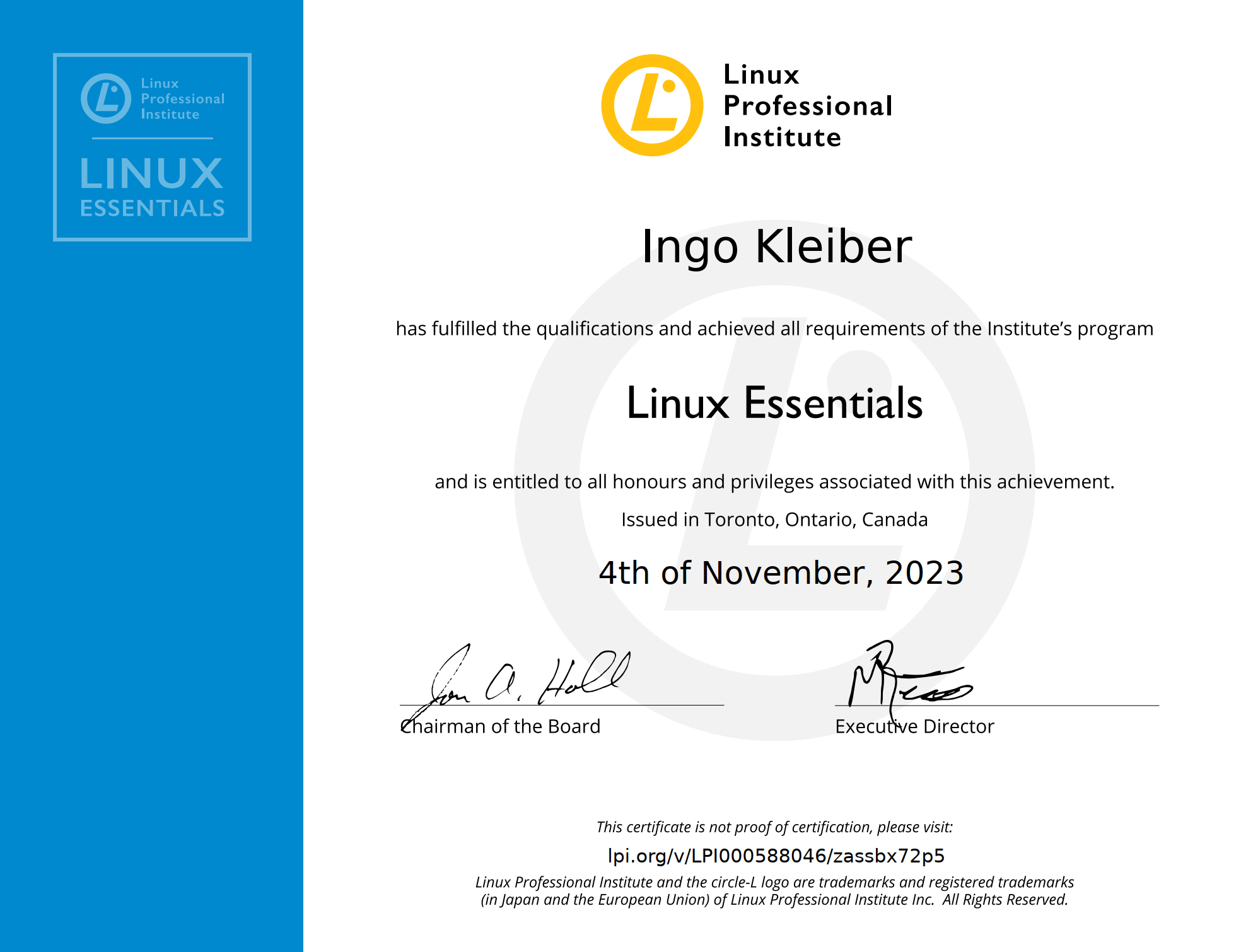Linux Professional Institute (LPI) Linux Essentials – A Great Starting Point for Structured Learning

Note: This article refers to version 1.6 (010-160) of LPI’s Linux Essentials certification.
As Linux adoption grows and grows, Linux competencies are foundational in many IT-related areas and fields. Interestingly, these go beyond apparent choices such as software engineering, cloud, cybersecurity, or IT infrastructure. For example, Linux is already indispensable in many research fields – whether we are looking at conducting research, analyzing data, building models, or managing research data.
My first encounter with Linux was, if I remember correctly, Suse Linux Professional 9 in 2003 or 2004. I was a (nerdy) young teenager at the time and just played around with it, primarily relying on the very (!) exhaustive handbook it came with. I have no idea why I started with a commercial distribution, but it did not take long before I used up my first spindle of CD-Rs in order to try a myriad of different distributions. From there, my learning and experimentation continued informally – I have never taken any Linux-specific courses.
While it is, at least in principle, easy to get into Linux this way – there are, naturally, thousands of great free (and open) resources – it is also very challenging to navigate the breadth of distributions, tutorials, courses, etc.
As more and more people, especially also students, have asked me where to start, I had a look at both such self-guided resources and the certification landscape. While one could argue over (pricy) IT certifications for a long time, they provide both a structured approach to a subject and the opportunity (and possibly motivation) to get a credential, allowing you to show off your competencies to others.
In this article, I will discuss the Linux Essentials certification by the Linux Professional Institute (LPI). It is, very likely, the most fundamental Linux certification by a recognizable entity and, having gone through both the learning experience and the exam, a great starting point for structured learning.
The Linux Certification Landscape
The following will be a very brief overview of the Linux certification landscape focusing on so-called entry-level certifications. While it is by no means exhaustive, it is helpful to understand where the Linux Essentials certifications falls within the range of offers.
There are a number of widely recognized entry-level Linux certifications. On the vendor-neutral side, the most prominent offers are CompTIA’s Linux+, LPI’s LPIC-1, and The Linux Foundation’s LFCS.
On the vendor-specific side of things, we have, for example, Red Hat’s Certified System Administrator (RHCSA), Oracle’s Certified Professional Oracle Linux 8 System Administrator, or the security-focused KLCP by OffSec.
Of course, the same providers and vendors also offer higher-level certifications, such as the LPIC-2 or the LPIC-3 variants.
While I will not to discuss their differences, they all have in common that they are targeted toward more experienced users and/or (early career) administrators. For example, CompTIA’s Linux+ “validates the competencies required of an early career systems administrator supporting Linux systems,” while LPI’s LPIC-1 “is designed to reflect current research and validate a candidate’s proficiency in real world system administration.” Furthermore, they come at relatively high prices and usually require recertification every couple of years.
This is where LPI’s Linux Essentials comes in!
Linux Professional Institute (LPI) – Linux Essentials
In the words of Shawn Powers, who also has a fantastic YouTube playlist on the certifications, Linux Essentials is almost like a “pre-calc” that one would take before diving deeper.
The Linux Professional Institute positions Linux Essentials, in their own words, “as a great introduction to the more complete and advanced Linux Professional certification track.” It is meant as a foundational learning experience and certification that sits before the previously mentioned “entry-level certifications” and serves as either a stepping stone or a stand-alone certification for those learners who need some Linux competencies but don’t want to go in, for example, server administration (yet).
Having gone through the associated learning experience and having passed the exam, I can confidently say that LPI has achieved its goal with Linux Essentials. As I will discuss in more detail below, Linux Essentials is a great and, arguably, affordable starting point for those who are on the search for a structured learning opportunity.
My only real issue with Linux Essentials, especially the exam itself, is how heavily it is knowledge-based. While this makes sense given the positioning as a foundational learning experience, I would have loved to see some more applied, competency-based learning and assessment activities.
All of that said, a common question in the context of certifications is whether they are “valuable.” While I would love to start a huge discussion on the value of certifications and credentials in general, the question usually implies value in terms of getting a (better) job.
Looking at it from this perspective, I would argue that Linux Essentials definitely is not one of the ‘get the certification, get the job’ certifications that are, allegedly, out there. However, the Linux Professional Institute is a well-known entity, and depending on your desired career, it might be valuable to show that you have these fundamental competencies.
While I would most likely recommend skipping this certification if you want to become, for example, a Linux server administrator, it might be very valuable for someone who has to confidently use Linux in their job (e.g., a researcher).
Furthermore, compared to many of the other certifications mentioned, Linux Essentials is good for life. Hence, it is, with some caveats (see below), a one-time investment of about €130 (as of November 2023 in Germany).
The Learning Experience
The Linux Professional Institute offers a really neat learning experience leading to the certification exam that is completely free and, even better, openly licensed under a CC BY-NC-ND 4.0 license. This is great and, despite the very restrictive CC license, in the spirit of FOSS/FLOSS. I still would love to see a version that allows for derivates, especially thinking about creating courses leading to the certification. By the way, I am referring to version 1.6 of both the materials as well as the exam here!
The learning experience primarily consists of a digital textbook with a series of well-designed exercises. These can be viewed on the web or downloaded as one PDF. Furthermore, there is a long list of available third-party books, courses, and resources.
While the textbook-exercises approach could be more innovative, the Linux Essentials book is very well structured, clearly introduces background information and practical skills, and provides ample opportunity for exercises and exploration.
The book has chapters for each of the learning objectives and topics. For each topic, there are one or more lessons, each of which comes with both “Guided Exercises” as well as “Exploratory Exercises.” I was also very happy to see that they included answers to the exercises – something that is not always given.
While the guided exercises are heavily focused on doing very specific and concrete things (e.g., using specific commands), the exploratory exercises invite learners to apply their knowledge to new scenarios and explore their Linux system. The exercises, overall, are great, and I can only recommend them as they truly introduce a variety of common problems and tasks.
Personally, I think that the learning objectives are chosen very well. They offer a broad introduction to many important concepts while also providing some room for understanding some of the fundamentals and the philosophy of Linux. That said, the course is relatively technical, and one could question whether learners at this level need to know, for example, about hardware details or different CPU architectures. At times, the course feels like a general introduction to ICT concepts. However, for example, I really enjoy that learners are introduced to the basics of shell scripting, as scripting is a fantastic avenue into more “serious” programming.
Ultimately, while fairly traditional, LPI’s materials are a great start into (serious) Linux and computing, and I believe that it is worth looking at their materials whether or not you are interested in actually taking the exam. I also think that the materials could be a great teaching resource. Unfortunately, LPI opted for a restrictive CC license, so modifying the book is out of the question.
The Exam and Certification Experience
For obvious reasons, I cannot and do not want to say too much about the exam experience. In my case, I took the exam through OnVUE online proctoring and had, as with many previous exams, no issues worth mentioning.

The exam, as stated by LPI, contains 40 questions, and exam takers have 60 minutes to answer them. Having quite a bit of prior experience, I was able to finish and pass the exam in about 10 to 15 minutes. That said, it is a serious exam, and learners need to know the material. While I would have loved to see a more competency-based approach, I found the assessment to be fair and well-designed. Ultimately, the exam reflects the targeted learning objectives rather well.
From an economic perspective, the exam voucher is currently (November 2023) €110 (€130 after taxes). While certainly not cheap, I believe this to be a fair price for the exam and the credential. From a learning perspective, I do not think that the exam itself adds a lot on top of the exercise experience. Essentially, it is not worth taking the exam for the learning but only for the credential. Hence, as the learning experience is free, learners need to really consider whether the certification – the credential – is worth their money.
As I said above, the certification, compared to, for example, Linux+ or LPIC-1, is good for life and does not require recertification. In my opinion, whether a recertification scheme makes sense or not is clearly related to the learning objectives. In the case of Linux Essentials, it makes sense that they choose a lifelong model: All major knowledge areas and competencies outlined in the objectives are so fundamental that one can reasonably assume they will not drastically change over time.
Therefore, I really do appreciate that LPI, despite the clear earning opportunity, opted for a lifelong model which allows learners to get their foundational competencies certified.
Conclusion
LPI’s Linux Essentials is not a particularly prestigious certification that will almost automatically lead to recuiters reaching out. However, LPI managed to create a meaningful, albeit somewhat traditional, learning experience and an associated certification that neatly fills the gap before the established “entry-level” certifications in the Linux space.
Whether or not the certification is worth your time and money is up to your personal learning goals. Still, if you are looking for a well-structured learning opportunity to get you into Linux (administration), the Linux Essentials package is a great starting point.

Thank you for visiting!
I hope, you are enjoying the article! I'd love to get in touch! 😀
Follow me on LinkedIn